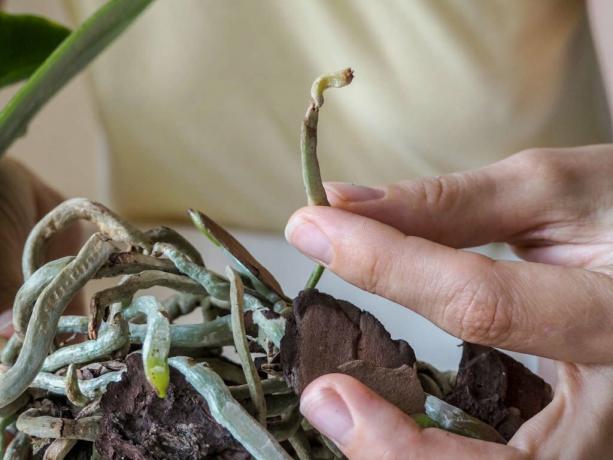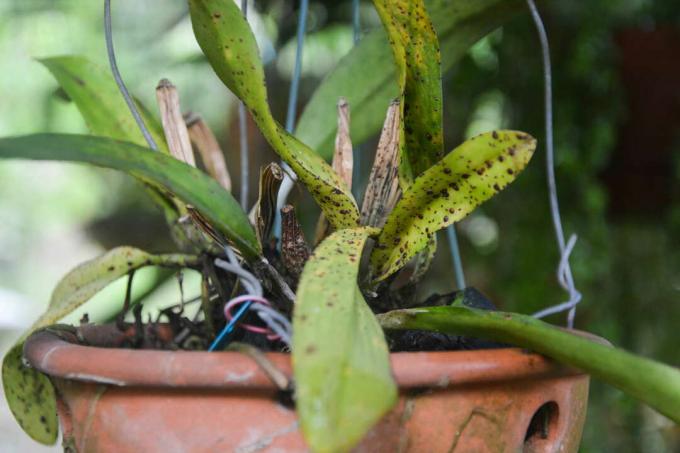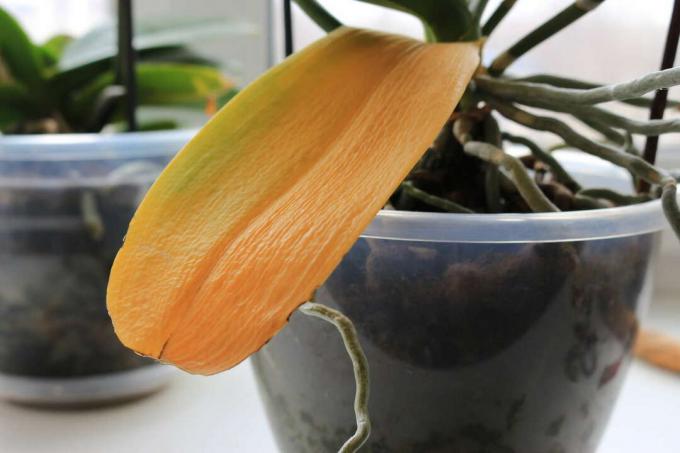If not cared for properly, orchids can often be plagued by diseases and pests. We have summarized what helps against this for you.

It's just standing orchid in a rich green and with bright flowers on the windowsill - but the next moment the leaves turn yellow or fall off. This and many other signs can be an indication of a disease of the popular houseplant, which sometimes gets into the house when you buy it. We present the most common diseases and pests in orchids and show what you can do about them.
contents
-
Orchids: The most common diseases
- rot
- accordion growth
- Brown spots on the leaves
- sunburn
- Orchids: Leaves turn yellow
- Orchids: Flowers fall off
-
Orchids: Common Pests
- Mealybugs on orchids
- Scale insects on orchids
- Aphids on orchids
Orchids: The most common diseases
As with any plant, the orchid has some signs by which you can recognize a disease. The following diseases are common:
rot
Probably the most common disease is root rot, which can reach up to the leaves. This is caused by bacteria that find optimal conditions through improper watering.

What can you do about it?
- Water only once a week
- Avoid waterlogging
- Repot the orchid
- Dispose of in an emergency
accordion growth
In the form of the leaves, also known as crinkle growth, which increases in orchid species how Miltonia or oncidium occurs, it is a reaction of the plants to changing environmental conditions. The leaves of the orchids only grow under the right conditions, such as suitable humidity and watering as well as the right temperature. In the event of deviations, the plant reacts by stopping growth. This change causes the characteristic growth, which is not particularly bad, but indicates incorrect care.
What can you do about it?
- Inform about the optimal site conditions for orchids
- Spray with water for high humidity
Brown spots on the leaves
This symptom often takes the form of dark spots that spread over time. This is usually a fungal infection that is also contagious to other plants. Bacteria can also be responsible for the disease.

What can you do about it?
- isolate plant
- No spraying with water
- Remove affected plant parts
- Enough air movement
- Disinfect knives
sunburn
Some orchid species are more sensitive to light than others and do not tolerate blazing sun well. Too much sun exposure can cause spots to appear on the plant.
What can you do about it?
- change location
- choose a place behind the curtain (no direct sunlight)
Below we have listed other symptoms that are also common in orchids.
Orchids: Leaves turn yellow
Basically, orchids such as Phalaenopsis can get a yellow leaf from time to time in winter, which then falls off. As long as the plant continues to sprout, there is no need to worry. If, on the other hand, several yellow leaves appear at the same time, this can be a sign that the roots have too little space and are rotting. A lack of light can also be responsible for leaf fall.

What can you do about it?
- Repot every two years
- Find a bright location
- No direct sunlight
Orchids: Flowers fall off
Just like the discoloration of the leaves, the dropping of the flowers is also a sign of the wrong site conditions for orchids. Reasons can be a strong change in temperature as well as drafts. Too much or too little sun and lack of water can also lead to the buds drying out.
What can you do about it?
- Ensure constant conditions
- Avoid direct sunlight
- Avoid a site on the north side in winter
- Floragard orchid soil: peat-free Special soil for the special requirements of your indoor orchids. Pine bark and coconut chips ensure a light and airy structure. Premium fertilizers such as guano ensure strong and vital plants.
- Cuxin liquid fertilizer for orchids: The special fertilizer for orchids contains many organic nutrients for lush flowering. Iron chelate ensures deep green leaves.
- Cuxin Foliar Care Spray: Care spray for orchids based on an ionic wetting agent. The trace elements it contains balance the moisture balance of orchids in a dry environment and thus ensure fresh green leaves and a high flowering rate.

Floragard orchid soil peat-free 5 L
12,10€
Details →

Cuxin liquid fertilizer for orchids, 400 ml
5,95€
Details →

CUXIN foliar care spray for orchids 250 ml
8,41€
Details →
Orchids: Common Pests
Most problems with orchids are caused by improper care, but even with proper handling, pests can creep in, which are usually brought in at the time of purchase.

Mealybugs on orchids
Mealybug are a common problem in orchids and can be identified by small, furry nests under the leaves. These are lice that feed on the sap of the orchid and thus damage it. Further infections often follow from an infestation with mealybugs.
What can you do about it?
- Remove nests with a cotton swab soaked in water or alcohol
- Wipe the plant thoroughly but gently
Scale insects on orchids
If you discover small animals with shield-shaped backs on your orchid, they are most likely the so-called scale insects. Like the mealybugs, the animals feed on the sap of the plant and thereby damage it.
What can you do about it?
- Dab the scale insects with tea tree oil
Aphids on orchids
As with many other plants, an orchid can in rare cases of aphids be infested. If you notice small white or black animals, your orchid has probably caught the annoying pests.
What can you do about it?
- Wipe the lice with light soapy water
With the right care, the risk of your orchids being attacked by diseases or pests can be significantly reduced. For example, in this article, you will learn how to Orchids properly fertilized.



